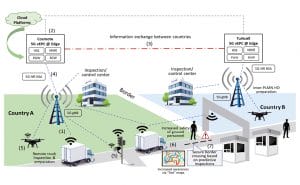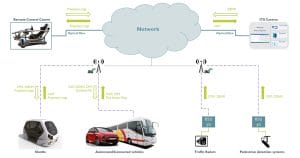The 5G-MOBIX project

Photo: © 2017 Hugo Cruz
Francois Fischer
ERTCO – ITS Europe
f.fischer(at)mail.ertico.com
5G is seen as a very important game changer for all sectors of industry. It is also addressing future societal needs, in particular in the context of mobility. 5G is expected to significantly progress the performance of autonomous vehicles by providing real-time connectivity and flexible mobile network services addressing automated mobility needs everywhere.
The 5G Action Plan for Europe
With the 5G Action Plan for Europe (5GAP), the European Union aims at achieving 5G deployment along the main transport corridors in the EU, with appropriate 5G coverage for autonomous vehicles in all Member States by 2025.
One particular challenge with the wide deployment of 5G along the main roads is the x-border areas, seen as regions with “mild” business cases for the telecommunication industry. Beyond the business case issues, technological challenges are expected relating to the roaming and handover situations as well as the needs of continuity of services relating to the Automated Driving needs. The European Union has launched a series of Innovation Actions under Horizon 2020 to address the 5G deployment needs for CCAM (Connected and Cooperative Automated Mobility), with a specific focus on the x-border challenges.
The 5G-MOBIX project is an integral part of the EU 5G Action Plan for Europe (5GAP) that brings together a united commitment and bold initiatives to ensure that the EU can use 5G connectivity as a strategic advantage to lead digital transformation and in particular in the area of Connected and Cooperative Automated Mobility (CCAM) with a strong focus on identifying and partially solving cross-border continuity of service issues.

Figure 1: 5G-MOBIX Greece-Turkey cross-border site
CCAM trials at two 5G corridors
5G-MOBIX will execute CCAM trials along two cross-border corridors, between Portugal and Spain (Porto-Vigo corridor) and between Greece and Turkey, with a specific focus on solving hard-border challenges of automated vehicles, like for instance truck platoons. Additionally, six national trial sites will contribute to the deployment and trials of the two cross border sites with advanced testing grounds and local competences about 5G network integrations and automated driving use cases testing.
The trials will allow 5G-MOBIX to conduct impact assessments, including business impact and cost/benefit analysis, particularly in sparsely populated cross-border areas with mild market failures of mobile network connectivity.
As a main impact, 5G-MOBIX will use the results of the trials, the international cooperation with its Chinese and Korean trial sites, and consultations with the public and industry stakeholders, to identify new business models for 5G-enabled CCAM. Furthermore, 5G-MOBIX will propose recommendations and options relating to standardisation, regulation and spectrum allocation to solve cross-border deployment challenges.
Existing key assets such as infrastructure and vehicles will be utilized and upgraded to test the smooth operation of 5G within a heterogeneous environment that includes other concurrent technologies such as ITS-G5 and C-V2X.
The Greece-Turkey 5G corridor
The Greece-Turkey corridor will offer the unique opportunity to address 5G cross-border deployment issues while driving across a hard border where trucks have to stop and are subject to human control. 5G-MOBIX will identify the opportunity to use 5G to allow crossing hard borders with automated truck platoons provided by FORD Otosan, firstly ensuring truck platooning continuity but also easing the customs controls (see figure 1).
The Portugal-Spain 5G corridor
The Porto-Vigo 5G cross-border corridor will be the place to trial several selected automated driving scenarios either on a highway or at two cross-border cities. The automated driving use cases will include complex manoeuvers for high-level automated-driving cars, remote control and monitoring of automated driving shuttle and Multimedia continuity of services for buses (see figure 2).

Figure 2: 5G-MOBIX Portugal-Spain cross-border site
Urban trial sites
There are four European urban trial sites – in Espoo (Finland), Versailles (France), Berlin (Germany) as well as Helmond Brainport in the Netherlands. They will support the two cross-border trials while offering the flexibility of experimenting with the deployment and integration of novel 5G technologies on an existing infrastructure. This allows trying out different deployment and configuration strategies, approaching the same automated driving use cases with simulated 5G cross-border environment (simulated handover), and providing also trials for national handover.
Finally, two Asian urban trial sites located in China (Jinan) and South Korea (Yeonggwang) are tightly coupled to 5G-MOBIX. They provide a worldwide perspective for the deployed technologies and the applicability of selected use cases. Harmonising the approach among the urban trial sites ensures maximum impact of 5G-MOBIX results and proposed solutions.
Further information is available on the5G-MOBIX website at WWW.5G-MOBIX.COM